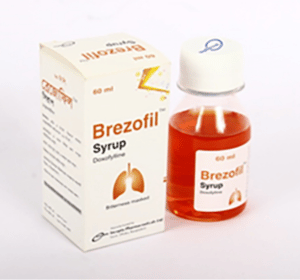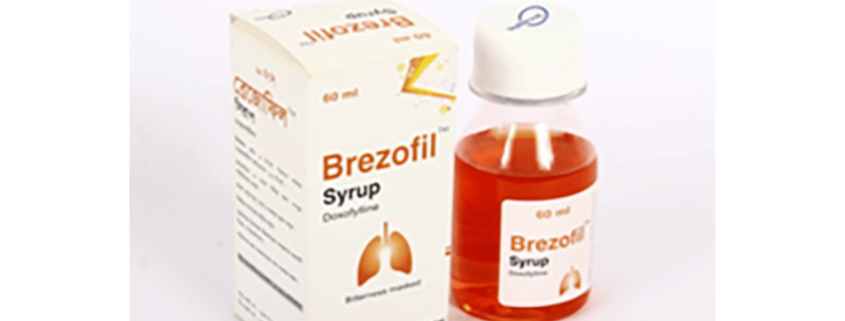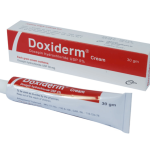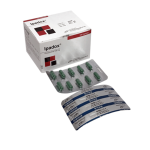Brezofil(Doxofylline)

Therapeutic Group: Respiratory
Presentation
BrezofilTM 200: Each tablet contains Doxofylline INN 200 mg.
BrezofilTM 400: Each tablet contains Doxofylline INN 400 mg.
BrezofilTM 400 SR: Each sustained release tablet contains Doxofylline INN 400 mg.
BrezofilTM Syrup: Each 5 ml syrup contains Doxofylline INN 100 mg.
Description
Doxofylline, a new generation xanthine belonging to a new class of drug referred to as Novofylline, which is chemically 1,3-dimethyl-3,7-dihydro-purine-2,6-dione. Its molecular formula is C11H14N4O4 and its molecular weight is 266.253 g/mol. Doxofylline is a new creation long lasting oral methylxanthine extract. Methylxanthines are from the family of phosphodiesterase inhibitors. Correspondingly, its system of activity is associated to the reticence of phosphodiesterase action, initiating in bronchodilating actions. It has a bronchodilator effect which reduces rate of breathlessness in patients suffering from asthma. It helps relax the muscles in the bronchi and bronchioles, thus causing dilatation of the air passages and helping patients to breathe easily. The drug also possesses antitussive properties which help to control the cough linked with lung disorders.
Indications
Doxofylline is mostly administered for maintenance treatment in subjects experiencing COPD (Chronic Obstructive Pulmonary Disease) and bronchial asthma. Doxofylline is not designed for use as an emergency treatment during an asthma attack.
Dosage & Administration
Tablet
Adults: 400 mg sustained release tablet once a day. Single dose, administration in the evening reduces nocturnal, symptoms and helps to keep the patients complaint free during the day. However, in certain cases, 400 mg tablet twice daily is recommended on the basis of the clinical response and according to disease severity. Doses as high as 1200mg/day (400 mg 3 times day) may also be prescribed.
Elderly: The dosage may be decreased according to medical prescription in the very elderly patients with concomitant cardiovascular, hepatic, renal and gastric disease, to 200 mg tablet b.i.d/ t.i.d.
Children >12 years: 200 mg 2 or 3 times daily.
Syrup
Children> 12 years: 10 ml, 2 or 3 times daily.
Children<12 years: 6 mg/kg/dose twice daily. In case of unsatisfactory response it can be increased up to 9 mg/kg/dose twice daily under medical supervision.
| Dosage | Weight of the child | ||||||
|---|---|---|---|---|---|---|---|
| 10 kg | 15 kg | 20 kg | 25 kg | 30 kg | 35 kg | 40 kg | |
| 6 mg/kg/dose b.i.d | 3 ml | 4.5 ml | 6 ml | 7.5 ml | 9 ml | 10.5 ml | 12 ml |
| Total daily dose | 6 ml | 9 ml | 12 ml | 15 ml | 18 ml | 21 ml | 24 ml |
Elderly: 10 ml, 2 or 3 times daily
Side Effects
After xanthine administration, nausea, vomiting, epigastric pain, cephalalgia, irritability, insomnia, tachycardia, extrasystole, tachypnea and occasionally, hyperglycemia and albuminuria, may occur. If a potential oral overdose is established, the patient may present with severe arrhythmias and seizure; these symptoms could be the first sign of an intoxication. Adverse reactions may cause the withdrawal from treatment; a lower dose rechallenge may start only after the advice of a physician.
Precautions
Use with caution in patients with hypoxemia, hyperthyroidism, liver disease, renal disease, in those with history of peptic ulcer and in elderly. Frequently, patients with Congestive Heart Failure (CHF) have markedly prolonged drug serum levels following discontinuation of Doxofylline.
Use in Pregnancy & Lactation
Animal reproduction studies indicate that Doxofylline does not cause fetal harm when administered to pregnant animals nor can affect reproduction capacity. However, since there is limited experience in human during pregnancy, xanthines should be given to a pregnant woman only if clearly needed.
Drug Interaction
Doxofylline should not be administered together with other xanthine derivatives. Toxic synergism with ephedrine has been documented for xanthines. Like other xanthines, concomitant therapy with erythromycin. troleandomycin, lincomycin, clindamycin, allopurinol, cimetidine, ranitidine, propranolol and anti-flu vaccine may decrease the hepatic clearance of xanthines causing an increase in blood levels. No evidence of a relationship between Doxofylline serum concentrations and toxic events have been reported.
Over Dose
Although no major arrhythmias have been documented with Doxofylline, the occurrence of major cardiac rhythm disturbances cannot be excluded in case of overdosage of xanthine compounds. If a potential oral overdose is established, the patient may present with seizures; this symptom could be the first sign of intoxication. Adverse reactions may cause withdrawal from treatment.
Storage
– Store at room temperature (not exceeding 25°C).
– Store in cool and dry place, protected from light.
Commercial Pack
Brezofil: Each box contains 3 blister strips of 10 tablets.



